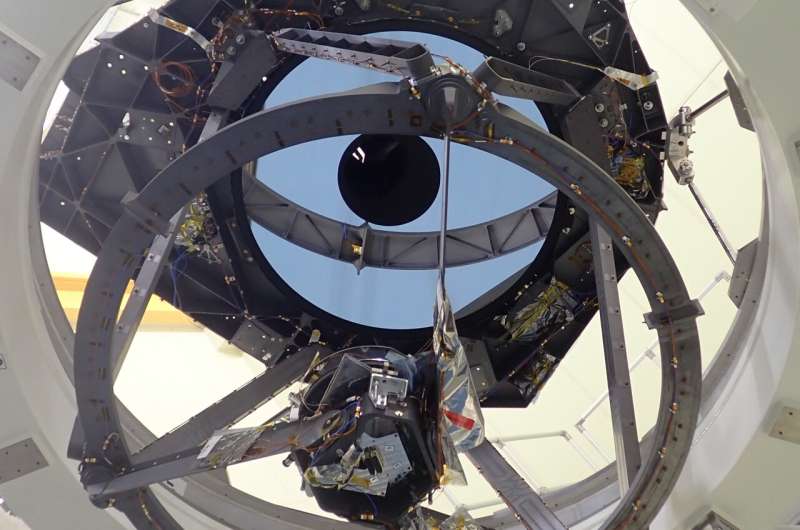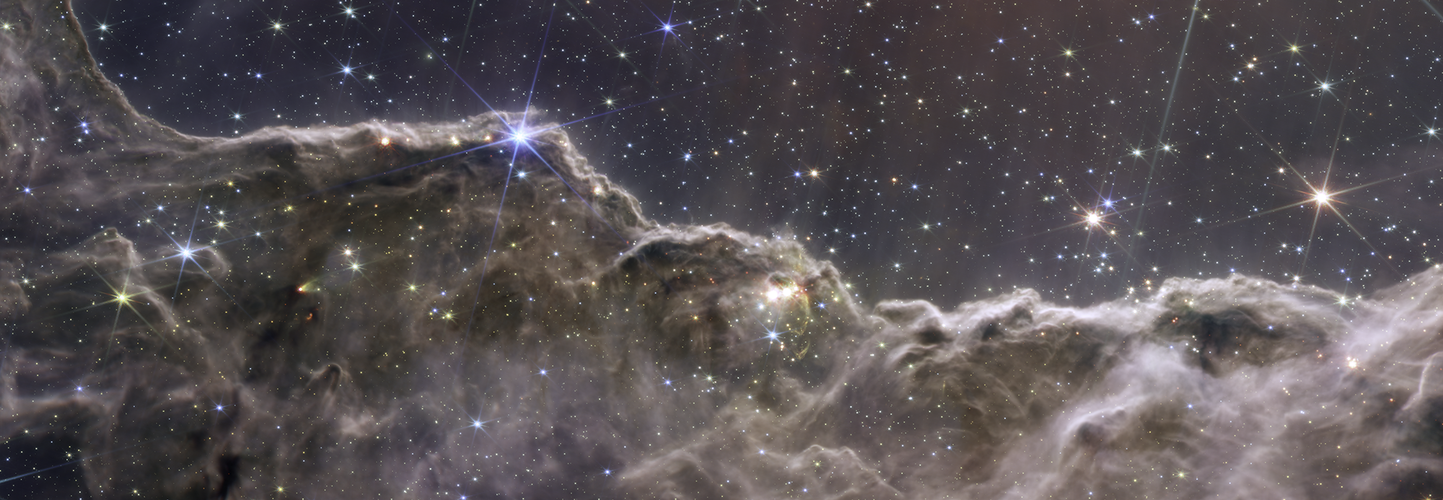
Copernical Team
Exploring Euclid's Korsch configuration mirrors

The 1.2-m diameter main mirror of ESA's Euclid mission to unveil the dark universe, seen during assembly, integration and testing. Using this mirror, the spacecraft will map the 3D distribution of billions of galaxies up to 10 billion light years away—looking beyond the Milky Way galaxy to image around a third of the observable universe. By revealing the universe's large-scale structure, and its pattern of expansion, the mission will cast light on the mysterious dark energy and dark matter making up 95% of the cosmos.
All six of Euclid's Korsch configuration mirrors, plus the telescope itself—comprising more than 30 parts as well as the mirrors—as well as the more than 10 parts making up the mission's Near Infrared Spectrometer and Photometer and the optical bench that surrounds them are all made from the same material: not glass, but a ceramic only found naturally in space.
Silicon carbide (SiC) is one of the hardest materials known, used to make cutting tools, high-performance brakes and even bulletproof vests, while being much lighter than glass. It is similar to a metal in having high thermal conductivity but unlike metals can undergo extreme temperature shifts without deforming—making it very attractive for space-based astronomy.
All new ESA photo library for high-resolution images

Our ‘ESA Photolibrary for Professionals’ platform has relaunched with a new modern user interface, additional search features and download options. Register for a user account and you can access the largest selection of high-resolution professional images from ESA.
'Smiling cat' nebula captured in new ESO image
 This cloud of orange and red, part of the Sh2-284 nebula, is shown here in spectacular detail using data from the VLT Survey Telescope, hosted by the European Southern Observatory (ESO). This nebula is teeming with young stars, as gas and dust within it clumps together to form new suns. If you take a look at the cloud as a whole, you might be able to make out the face of a cat, smiling down from
This cloud of orange and red, part of the Sh2-284 nebula, is shown here in spectacular detail using data from the VLT Survey Telescope, hosted by the European Southern Observatory (ESO). This nebula is teeming with young stars, as gas and dust within it clumps together to form new suns. If you take a look at the cloud as a whole, you might be able to make out the face of a cat, smiling down from Gravity and dark matter, a bond beyond distances
 Isaac Newton formulated his theory of gravity as an action at a distance: a planet instantly feels the influence of another celestial body, no matter the distance between them. This characteristic motivated Einstein to develop the famous theory of general relativity, where gravity becomes a local deformation of spacetime. The principle of locality states that an object is directly influenced onl
Isaac Newton formulated his theory of gravity as an action at a distance: a planet instantly feels the influence of another celestial body, no matter the distance between them. This characteristic motivated Einstein to develop the famous theory of general relativity, where gravity becomes a local deformation of spacetime. The principle of locality states that an object is directly influenced onl Back on Track: Sols 3871-3872
 We started planning today with the great news that our drive was successful! This put us in a perfect position for our split touch-and-go plan - lots to see, and no need to worry that we might be on unsteady footing, like we were on Friday.
Our two nearby targets are bedrock blocks: the nodular bedrock 'Lousoi,' which we'll be investigating up close (the 'touching' in the touch-and-go) wit
We started planning today with the great news that our drive was successful! This put us in a perfect position for our split touch-and-go plan - lots to see, and no need to worry that we might be on unsteady footing, like we were on Friday.
Our two nearby targets are bedrock blocks: the nodular bedrock 'Lousoi,' which we'll be investigating up close (the 'touching' in the touch-and-go) wit Zhurong rover detects extremely weak magnetic fields on surface of Mars' Utopia Basin
 A joint research team led by Prof. DU Aimin from the Institute of Geology and Geophysics of the Chinese Academy of Sciences (IGGCAS) has found extremely weak magnetic fields during the Zhurong rover's first 1-km traverse on Mars. This indicates no detectable magnetization anomalies below Zhurong's landing site.
The researchers utilized two fluxgate magnetometers aboard the Zhurong rover to
A joint research team led by Prof. DU Aimin from the Institute of Geology and Geophysics of the Chinese Academy of Sciences (IGGCAS) has found extremely weak magnetic fields during the Zhurong rover's first 1-km traverse on Mars. This indicates no detectable magnetization anomalies below Zhurong's landing site.
The researchers utilized two fluxgate magnetometers aboard the Zhurong rover to Advanced space technology enabling 2024 ESCAPADE mission to Mars
 Advanced Space, an industry frontrunner in the creation of cutting-edge space technology, is set to make significant strides in deep space and planetary exploration through its collaboration with the University of California Berkeley Space Sciences Laboratory (SSL).
The partnership centers around NASA's forthcoming Escape and Plasma Acceleration and Dynamics Explorers (ESCAPADE) mission, s
Advanced Space, an industry frontrunner in the creation of cutting-edge space technology, is set to make significant strides in deep space and planetary exploration through its collaboration with the University of California Berkeley Space Sciences Laboratory (SSL).
The partnership centers around NASA's forthcoming Escape and Plasma Acceleration and Dynamics Explorers (ESCAPADE) mission, s France tests hypersonic glider for first time
 France has for the first time tested a hypersonic glide vehicle, a warhead that defies interception thanks to its unpredictable trajectory, a source with knowledge of the test said Tuesday.
The speed of HGVs can exceed Mach 5, or 6,000 kilometres per hour (3,730 mph). The technology is being developed or deployed by a small number of countries that includes China, Russia and the United State
France has for the first time tested a hypersonic glide vehicle, a warhead that defies interception thanks to its unpredictable trajectory, a source with knowledge of the test said Tuesday.
The speed of HGVs can exceed Mach 5, or 6,000 kilometres per hour (3,730 mph). The technology is being developed or deployed by a small number of countries that includes China, Russia and the United State Leidos' MACH-TB program successfully completes 1st test launch
 Leidos (NYSE: LDOS), a Fortune 500 technology, engineering and science solutions and service leader, announced its Dynetics team has successfully completed a large-scale test for its MACH-TB program. The Multi-Service Advanced Capability Hypersonic Test Bed (MACH-TB) program is meant to increase the speed of testing for all commercially available hypersonic systems. The program also called for t
Leidos (NYSE: LDOS), a Fortune 500 technology, engineering and science solutions and service leader, announced its Dynetics team has successfully completed a large-scale test for its MACH-TB program. The Multi-Service Advanced Capability Hypersonic Test Bed (MACH-TB) program is meant to increase the speed of testing for all commercially available hypersonic systems. The program also called for t Virginia Tech leads multi-institution research on polymeric solid fuel combustion
 Fascination surrounding spaceflight and rockets is at an all-time high. Sites near launchpads draw crowds of spectators, eager to witness the flash of fire and feel the vibrations as the rumble of the motor becomes a roar. People, squinting and craning their necks to watch the rocket hurtle out of sight, aren't likely thinking about the science behind the propulsion that makes it all possible.
Fascination surrounding spaceflight and rockets is at an all-time high. Sites near launchpads draw crowds of spectators, eager to witness the flash of fire and feel the vibrations as the rumble of the motor becomes a roar. People, squinting and craning their necks to watch the rocket hurtle out of sight, aren't likely thinking about the science behind the propulsion that makes it all possible. 